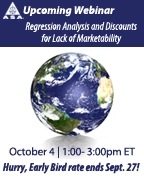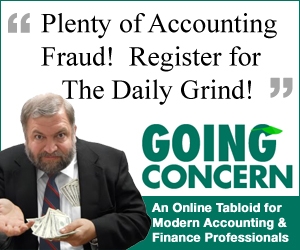
| September 28, 2011 | Issue #108-3 |
Liquidity effect is significant—more so than the size effect, says new study by Abbott & Pratt Just last week BVR was privileged to preview the new study by Ashok Abbott, Ph.D. (Univ. of West Va.), and Shannon Pratt (SPV), “Size Effect and Liquidity Premium: Substitutes or Supplements.” Building on over 30 years of academic research into the size effect and the more recent research concerning liquidity discounts, Abbott and Pratt set out to answer the question: Is size just a proxy for liquidity? (Abbott admits they were also prompted by the article, Business Valuation, DLOM, and Daubert, in which Robert Comment, Ph.D., concludes, “Because there is a strong empirical relation between size and liquidity, there is a great likelihood that any supplemental discounting for illiquidity will be redundant and entail double discounting.”) After months spent analyzing empirical market data from three major exchanges—including 25 million-plus daily observations and 1 million-plus monthly observations, Abbott and Pratt found, as expected, that the relationship between size and liquidity is not statistically significant. “They are not substitutes for each other,” Abbott says. The data also confirmed the previously reported negative correlations between returns and both liquidity and size; that is, the larger market value firms exhibit lower returns, as do the more liquid firms. The ultimate query: Is the difference in returns for different size quintiles (using standard Ibbotson categories) statistically significant? In a word—yes. “Significant differences exist between observed returns for different size quintiles, and for different liquidity quintiles,” Abbott says. Moreover, “liquidity has a stronger impact than size, significantly so.” Liquidity matters, he says, “much more” than expected. “That is the surprising contribution from the study,” Abbott adds. The practical takeaway for analysts: “They will first make a size adjustment to the rate of return, as they have always done,” he says, “and then they will have to look at liquidity and make an adjustment for that.” Catch both presenters and their complete findings at the ASA’s 2011 Advanced BV Conference, October 10-12 in Chicago. Is the DLOM ‘meaningless’ outside of the ‘BV bubble’? “I have watched the BV community's response to the IRS DLOM Job Aid with interest,” says Nancy Fannon (Fannon Valuation Group). “The old adage, ‘he who controls the product controls the discussion,’ is true nowhere more than in this particular debate.” Prompted by the debate (and completely independent of Abbott’s liquidity presentation to BVR), Fannon reached out to Robert Comment for his perspective: “I think this debate is intelligible only within the BV bubble, where it is traditionally but naively assumed (apparently even by the IRS) that restricted-stock discounts are solely attributable to the regulatory restriction on marketability,” Comment says. The tradition dates back to the SEC's Institutional Investor Study, when issuers could only privately place restricted stock. “To my knowledge, nobody outside the BV bubble still relies on this naive and transparently false assumption,” he adds, which cannot survive the fact that “private placements of free-trading shares are also sold at a discount, on average.” In fact, Comment’s recent paper, "A Skeptical Restricted-Stock Study," concludes that the regulatory restriction is not even the primary cause of restricted stock discounts, nor is it significantly (statistically) different from the DLOM on the riskless asset, which approximates 2.5%. “In a nutshell, the average discount in a sample of private placements of restricted stock is a naive, biased, and unreliable measure of the DLOM,” Comment maintains. “This is true even in a sample that is selected to be comparable to the subject company. Based on evidence from my ‘skeptical’ restricted-stock study, the DLOM is not reliably different from 2.5%." Read more of Dr. Comment’s response—including the “proper” regression analysis to use when measuring DLOM data—in an upcoming Business Valuation Update. Survey asks: Is the IRS DLOM Job Aid a ‘blockbuster’ or a bust? One thing is certain: the debate on determining marketability discounts is not going to die down any time soon, especially given the current firestorm surrounding the IRS DLOM Job Aid. But—is the Job Aid a “blockbuster document,” as some analysts have said, or is it simply more evidence that DLOM matters only to those who produce it? Take this quick, 5-question survey to give us your (anonymous) thoughts and insights. We’ll publish the results next week, in advance of BVR’s special 100-minute webinar, FMV Responds to the IRS DLOM Job Aid, in which Lance Hall (FMV Opinions) will address the IRS Job Aid, what it means for business appraisers, and how to approach your DLOM determinations in light of this document. NACVA encourages analysts to get all the facts on credentials Any viewpoint that one BV credential is better than another is “unfortunate,” says NACVA president, Scott R. Saltzman, CPA, CVA, ASA, CFFA, in response to the recent article by R.J. Dragon. “Each business valuation organization and/or credential has its own unique elements,” Saltzman adds. In particular, he’d like to point out the following concerning the NACVA training and credentialing process:
NACVA “has always welcomed the opportunity to work with our fellow BV organizations,” Saltzman says, and will continue to do so in the future. To obtain an overview of the various BV credentials, he suggests visiting NACVA’s credential comparison chart. What the BV profession really needs: As a credentialed member of multiple BV organizations, and with a long history of elected leadership and faculty positions in each, Bill Quackenbush (Advent Valuation Advisors) believes that “all other things equal, the higher the bar is set (and this is an important assumption), the better qualified credentialed practitioners should be.” In addition to setting high entrance levels, the BV profession should also consider better policing. Says Quackenbush:
Reminder: the November BVUpdate will feature a complete summary of all views on BV credentialing. Court warns Oracle/Google to follow ‘road map’ in calculating royalties under entire market value rule Soon after Oracle filed claims that Google infringed its patented Java software in the Android system, the federal district court made a mistake: it let Oracle submit its expert damages report early. Instead of expediting trial preparation (and settlement), the expert’s report simply “overreached in multiple ways,” the court said, “compounding damages ever higher into the billions—evidently with the goal of seeing how much it could get away with.” But that won’t happen again. “Please be forewarned: the next bite will be for keeps,” the court said, in permitting Oracle’s expert to supplement his report by specifically apportioning damages to the patented features rather than Java’s application in the entire Android system. “The fact that Java may be a critical component of Android does not justify application of the entire market value rule,” it held, citing the Federal Circuit’s recent decision in Uniloc v. Microsoft. Pursuant to that case, the court also rejected the “Nash bargaining model” (developed by Nobel Prize winner John F. Nash, Jr.) for use in any reasonable royalty calculations. Instead, it strongly advised the expert to use the unsuccessful but “real world” negotiations between the parties as a starting point and then provided a six-point roadmap for adjustments to any reasonable royalty under Georgia-Pacific. Read the digest of Oracle Inc. v. Google Inc., 2011 WL 2976449 (N.D. Cal.)(July 22, 2011) in the October Business Valuation Update; the court’s opinion is already posted at BVLaw. Keep current on the rule. Since Uniloc, we’ve covered nearly half a dozen new cases that interpret expert damages evidence under the courts’ more stringent application of the entire market value rule. On Thursday, October 6, join Craig Jacobson (Citrin Cooperman) and Stephen Lieb (Frommer Lawrence & Haug) for “Patent Damages: The Entire Market Value Rule.” This installment of BVR’s Online Symposium on Litigation & Economic Damages will discuss how the increasing dominance of intellectual property as a value-driver has placed a new burden on patent damages in general and entire market value analysis in particular. ESOP put option argument for mitigating DLOM is ‘fallacious,’ says new article “Virtually every ESOP appraisal that has been written in the past 10 years has concluded that, both in the case of purchases of company stock by an ESOP from direct shareholders and in the case of subsequent distributions and repurchases of company stock to and from plan participants, the discount for lack of marketability is greatly diminished by virtue of the ESOP ‘put option,’” writes John D. Menke (The Menke Group), whose new article reviews the origin and development of the put option argument in appraisal literature, including the first edition (1981) of Shannon Pratt’s Valuing a Business. Menke ultimately concludes “that (1) the put option argument is fallacious with respect to purchases of company stock from direct shareholders, and (2) nevertheless, there should be no marketability discount with respect to purchases of company stock from direct shareholders.” FASB announces effective date for goodwill impairment update Just two weeks ago, the FASB issued Accounting Standards Update No. 2011-08, Intangibles—Goodwill and Other (Topic 350): Testing Goodwill for Impairment. More recently, the FASB announced that the amendments in this update will be effective “for annual and interim goodwill impairment tests performed for fiscal years beginning after December 15, 2011.” Early adoption is permitted, the FASB adds, “including for annual and interim goodwill impairment tests performed as of a date before September 15, 2011, if an entity’s financial statements for the most recent annual or interim period have not yet been issued or, for nonpublic entities, have not yet been made available for issuance.” Read Brad Pursel’s analysis of the new standard and its qualitative requirements in the November BVUpdate. How to calculate lost business under insurance claims Next Tuesday, October 4, don’t miss “Calculating Damages for Insured Claims.” In this second installment of BVR’s Online Symposium on Litigation & Economic Damages, attorneys John Garaffa (Butler Pappas) and Jack Montgomery (Bernstein Shur) will discuss of the determination, calculation, analysis, and presentation of economic damages claims involving insurance, including lost profits due to business interruption and lost business value.
To ensure this email is delivered to your inbox, please add editor@bvwire.com to your e-mail address book. We respect your online time and privacy and pledge not to abuse this medium. To unsubscribe to BVWire™ reply to this e-mail with 'REMOVE BVWire' in the subject line or click here. This email was sent to %%emailaddress%% Copyright © 2011 by Business Valuation Resources, LLC |
|






